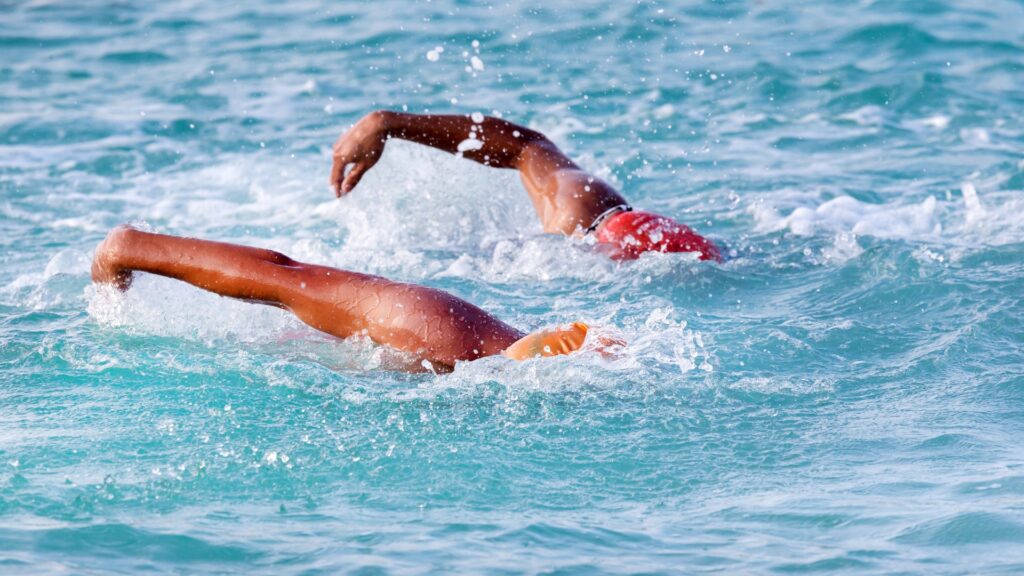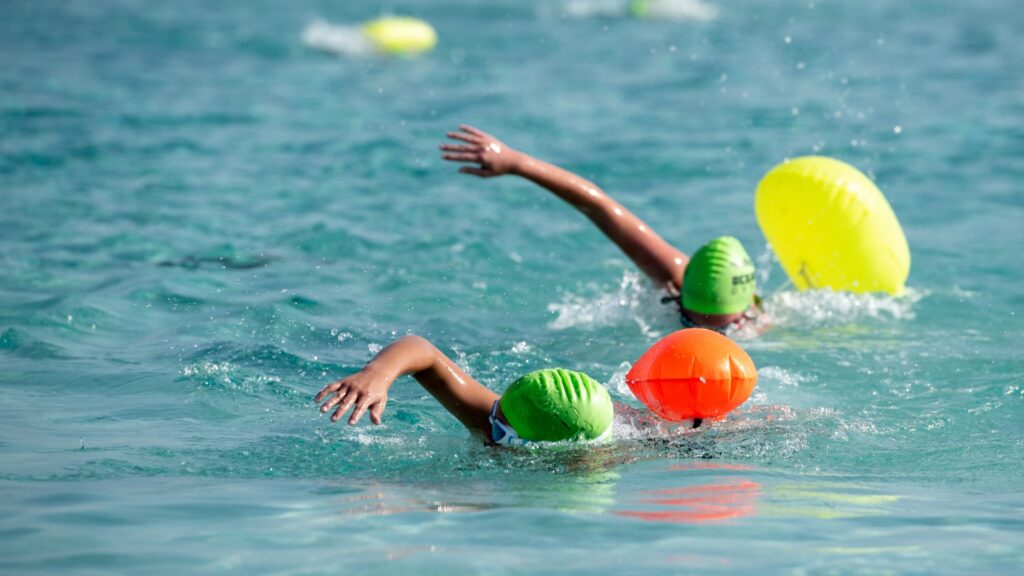Transitioning from pool swimming to open water can be challenging for many triathletes. The controlled environment of a pool contrasts sharply with the unpredictable nature of open water. Here are some effective tips to help you enhance your open-water swimming performance.

Understanding the Differences
Environment and Conditions
Swimming in open water is vastly different from pool swimming. There are no lane lines or walls to guide you, and you have to deal with factors like currents, waves, and the presence of other swimmers. These conditions can significantly impact your stroke and navigation.
Stroke Adaptation
In open water, your stroke will naturally change. You need to lift your head to sight for buoys, which alters your body position and stroke mechanics. Additionally, the presence of other swimmers means you might get bumped, requiring you to maintain your rhythm despite disruptions.
Practical Tips for Open Water Training
Simulate Race Conditions in the Pool
While training in open water regularly is ideal, it’s not always feasible. You can simulate race conditions in the pool to better prepare for open water swimming:
- Group Swimming: Swim with others in the same lane to mimic the crowded conditions of a race. Practice sprinting for short distances with easy lengths in between to get used to the feeling of having swimmers around you.
- Contact Practice: Allow some light physical contact during these sessions. Getting bumped or having your feet touched can be unsettling if you’re not used to it, so practicing this can help you stay calm during a race.
Practice Sighting
Sighting is crucial in open water to stay on course. Incorporate sighting drills into your pool sessions:
- Lift and Look: Every few strokes, practice lifting your head just enough to see ahead. This will help you get used to the motion and maintain your direction without significantly disrupting your stroke.

Use Your Wetsuit
Wearing a wetsuit can significantly impact your swimming mechanics. Practice swimming in your wetsuit in the pool:
- Short Sessions: Do short, intense sessions in your wetsuit to get used to the buoyancy and restriction, especially around the shoulders.
- Rinse After Use: Always rinse your wetsuit thoroughly after swimming in a chlorinated pool to prevent damage.
Drafting Practice
Drafting behind or beside another swimmer can save energy during a race. Practice this technique in the pool to become more efficient:
- Close Proximity: Swim closely behind another swimmer, maintaining a position where you can benefit from the reduced water resistance.
Improve Your Endurance and Strength
Open water swimming requires both endurance and strength, particularly when dealing with currents and waves:
- Endurance Training: Include longer swim sessions in your training to build stamina. Aim for continuous swims with minimal breaks to mimic race conditions.
- Strength Training: Incorporate strength training exercises, focusing on the upper body, core, and legs. This will help you power through waves and maintain form when fatigued.
Making sure you do the correct strength training is important. The good news is we’ve created a free strength training plan for runners that you can download by clicking here.
Breathing Techniques
Proper breathing techniques are essential for open water swimming. The unpredictability of the environment can disrupt your breathing rhythm, so it’s crucial to practice bilateral breathing:
- Bilateral Breathing: Alternate breathing on both sides during training. This practice helps you adapt to waves and currents that might come from either side, ensuring you can breathe comfortably regardless of conditions.
Mental Preparation
The mental aspect of open water swimming is as important as the physical. Being prepared for the unexpected can make a significant difference:
- Visualization: Visualize the race day scenario, including the start, dealing with waves, sighting, and finishing strong. This mental rehearsal can help reduce anxiety and improve confidence.
- Calm Breathing: Practice calm and rhythmic breathing, both in training and during visualization exercises. Staying calm helps you conserve energy and maintain focus.
Equipment Familiarity
Getting comfortable with your equipment can significantly impact your open water performance:
- Goggles: Test your goggles in open water to ensure they don’t fog up and provide clear visibility. Adjust them for a secure fit to prevent leaks.
- Swim Cap: Practice with your race-day swim cap to get used to its feel and how it affects your swim.

Nutrition and Hydration
Proper nutrition and hydration can enhance your performance and endurance in open water:
- Pre-Race Nutrition: Consume a balanced meal with carbohydrates and proteins a few hours before your swim. Avoid heavy foods that might cause discomfort.
- Hydration: Stay hydrated leading up to the swim, but avoid excessive fluid intake just before entering the water to prevent feeling bloated.
Improving your open water swimming performance requires adapting your pool training to simulate open water conditions as much as possible. By incorporating these practical tips, you can better prepare yourself for the unique challenges of open water swimming, enhancing your performance and confidence on race day.



Comments are closed.